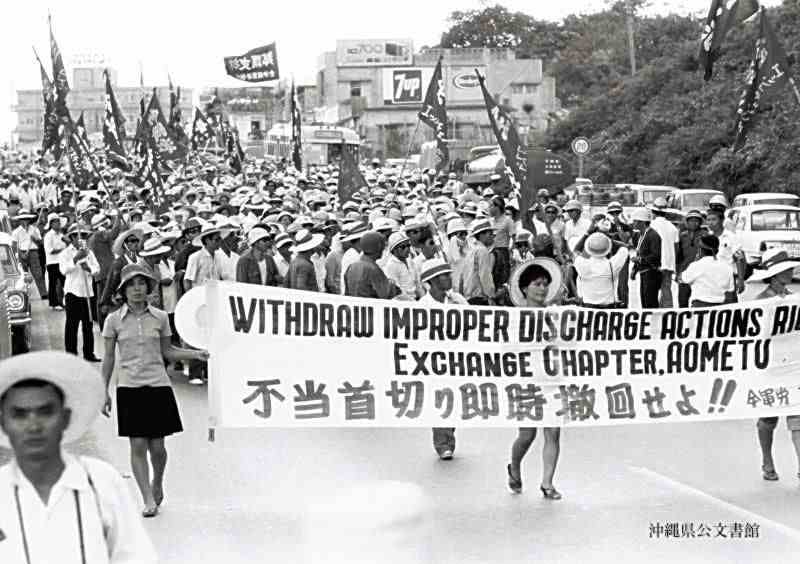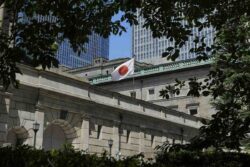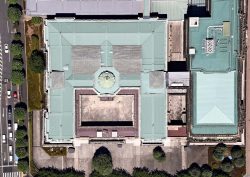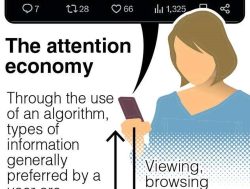
U.S. base workers hold a strike to protest against mass layoffs on Sept. 10, 1970.
The Yomiuri Shimbun
12:50 JST, January 26, 2022
This year, Okinawa marks the 50th anniversary of its return to Japan. This is the third installment of a series that explores some of the issues that have affected Okinawa people since the handover, leading up to the present day.
With its beautiful green grass and views overlooking the clear blue ocean, a picturesque golf course stretches out over some high ground in what is now the city of Nanjo near the southern tip of Okinawa Prefecture’s main island. But until the United States returned this land two years after the prefecture reverted to Japanese control, this course in what was then the town of Tamagusuku had been the site of Camp Chinen — a U.S. military base.
The return of this land was part of the drive to reorganize and reduce U.S. bases in accordance with Okinawa’s reversion to Japan. Spurred in part by the deteriorating U.S. financial situation, the U.S. military announced on Dec. 4, 1969 – just 13 days after the Japanese and U.S. governments had agreed Okinawa would be returned — that about 2,400 workers at U.S. bases in Okinawa would be laid off.

Tokusuke Serikyaku talks about his time working at the U.S. military base named Camp Chinen, which is now the golf course behind him, in Nanjo, Okinawa Prefecture, on Jan. 6.
More employees were dismissed over the following months with the purpose of cutting expenses, even while the bases’ functions were maintained. Some base workers even staged a strike to protest against the job cuts. In the end, a total of about 7,000 workers had lost their jobs by the time Okinawa was returned to Japan in May 1972.
Tokusuke Serikyaku, who had been working at Camp Chinen, still remembers feeling at a loss when the decision to return the base was made in 1971. “I wondered how I’d be able to make ends meet,” recalled 86-year-old Serikyaku, who lives in Nanjo.
At the time,Serikyaku’s monthly salary had been about ¥120,000. An acquaintance helped Serikyaku find a job at the village government office, but his salary plunged to about ¥60,000. With four children to raise, Serikyaku’s wife and mother also started working part-time.
Serikyaku was 10 when the Battle of Okinawa was fought. He escaped the bombardment of the island by U.S. warships — an assault that local residents called an “iron storm.” His grandfather died after contracting malaria in a civilian internment camp run by the U.S. military.
“I hated the United States for making Okinawa suffer so much,” Serikyaku said. “But the only jobs here were in agriculture, and I couldn’t earn enough money that way.”
With few options available,Serikyaku decided to seek work at Camp Chinen, the biggest source of jobs in the area.
Working at the base was tough for someone who had seen the Battle of Okinawa firsthand. The bases were staging areas for shipping supplies to U.S. military units that conducted missions during the Vietnam War, and rifles were repaired there and sent to the front line.
“I constantly asked myself if I was being complicit in that war,” Serikyaku said. “But I had no other choice to maintain my living.”
Still a vital source of employment
At the time, Okinawa lacked any industries that could soak up the vast number of workers laid off by the U.S. military. For many residents, the reversion to Japan was a time of uncertainty and discontent.
Seikou Yogi, 76, was in charge of human resources at an organization that operated a supermarket and other facilities inside the bases. He had to translate the notices of dismissal and tell workers they were being laid off. Many of the workers became hostile toward Yogi because they felt he “was on the U.S. military’s side.” Posters slandering Yogi were even posted on walls near his home.
Many of the Americans at the supermarket looked down on the workers and barked instructions at them. Some workers who were not laid off became fed up after Okinawa’s reversion and quit with a promise “never to set foot on the base again.” However, the difficulty of finding good jobs and the meager salaries outside the bases was often too much to bear, and many eventually returned and asked to be rehired at the military facilities.
The U.S. bases remain a major source of employment in Okinawa Prefecture. Although the number of workers at these bases has dropped from about 19,000 at the time of Okinawa’s reversion to about 9,000 now, this figure is still almost double the number of employees at the prefectural government.
According to recruitment information from the Labor Management Organization for U.S. Forces in Japan Employees, an incorporated administrative agency that hires and handles administrative matters for employees at U.S. bases, basic monthly salaries range from ¥163,200 to ¥248,200. This compares favorably with the ¥182,200 starting salary for a new university graduate at the prefectural government.
Competition for the about 260 to 640 jobs that become available at the bases annually is intense, with applicants outnumbering vacancies by about 10 to one.
A vocational school in Naha previously offered a course titled “specialization for on-base employment.” The name has since been changed, partly because public opinion on the bases is split in Okinawa, but even today, students undergo training at restaurants inside the bases and one or two land jobs there each year. Okinawa Prefecture’s tourism industry has been battered by the novel coronavirus pandemic, which fueled a jump in people wishing to work at bases during the 2021 academic year. A record-high seven students from the school have found permanent full-time jobs at bases during this school year.
Jun Inafuku, a teacher at the school, has mixed feelings about the bases.
“The bases are here, and there’s been no end to accidents and incidents involving them, so that presents a dilemma,” said Inafuku, 53. “But if there were no bases, I don’t know where those workers could find other jobs.”
Popular Articles
Popular articles in the past 24 hours
-

Playful Bags from Brigitte Tanaka Evoke Parisian Atmosphere, Brin...
-

U.K. Public Urged to Keep Eyes Peeled for Washed-up Bananas
-

BOJ Decides to Raise Key Policy Rate to 0.75%
-

Japan, U.S. Start Talks on Tokyo's $550 Bil. Investment in U.S.; ...
-

Court Hears Arguments on Weight of Yamagami's Background in Sente...
-

Dangerous Driving: Eliminate Ambiguity to Impose Severe Punishmen...
-

Japan Long-Term Rate Hits 26-Yr High after BOJ Decision
-

Japan's 10-Year Bond Yield Hits 1999 High as BOJ Hikes Rates; Tec...
Popular articles in the past week
-

University of Tokyo Professor Discusses Japanese Economic Securit...
-

Tsukiji Market Urges Tourists to Avoid Visiting in Year-End
-

Israeli Tourists Refused Accommodation at Hotel in Japan’s Nagano...
-

China to Impose Sanctions on Shigeru Iwasaki, Former Head of Japa...
-

Japan to Support Central Asian Logistics Route That Bypasses Russ...
-

Speed Skater Yukino Yoshida Clinches Ticket to Milan
-

Chinese, Russian Bombers Flew Unusual Path by Heading Toward Toky...
-

BOJ Likely to Raise Policy Interest Rate as Impact from U.S. Tari...
Popular articles in the past month
-

Japan’s Hopes for Seafood Exports Shot Down in China Spat
-

Keidanren Chairman Yoshinobu Tsutsui Visits Kashiwazaki-Kariwa Nu...
-

Japan to Charge Foreigners More for Residence Permits, Looking to...
-

Imports of Rare Earths from China Facing Delays, May Be Caused by...
-

Japan Exports Rise in October as Slump in U.S. Sales Eases
-

University of Tokyo Professor Discusses Japanese Economic Securit...
-

Japan Pulls out of Vietnam Nuclear Project, Complicating Hanoi's ...
-

Govt Aims to Expand NISA Program Lineup, Abolish Age Restriction
"Society" POPULAR ARTICLE
-

M4.9 Earthquake Hits Tokyo, Neighboring Prefectures
-

M7.5 Earthquake Hits Northern Japan; Tsunami Waves Observed in Hokkaido, Aomori and Iwate Prefectures
-

Tsukiji Market Urges Tourists to Avoid Visiting in Year-End
-

Israeli Tourists Refused Accommodation at Hotel in Japan’s Nagano Pref., Prompting Protest by Israeli Embassy and Probe by Prefecture
-

M5.7 Earthquake Hits Japan’s Kumamoto Pref., Measuring Upper 5 Intensity, No Tsunami Expected
JN ACCESS RANKING
-

Keidanren Chairman Yoshinobu Tsutsui Visits Kashiwazaki-Kariwa Nuclear Power Plant; Inspects New Emergency Safety System
-

Imports of Rare Earths from China Facing Delays, May Be Caused by Deterioration of Japan-China Relations
-

University of Tokyo Professor Discusses Japanese Economic Security in Interview Ahead of Forum
-

Japan Pulls out of Vietnam Nuclear Project, Complicating Hanoi’s Power Plans
-

Govt Aims to Expand NISA Program Lineup, Abolish Age Restriction







